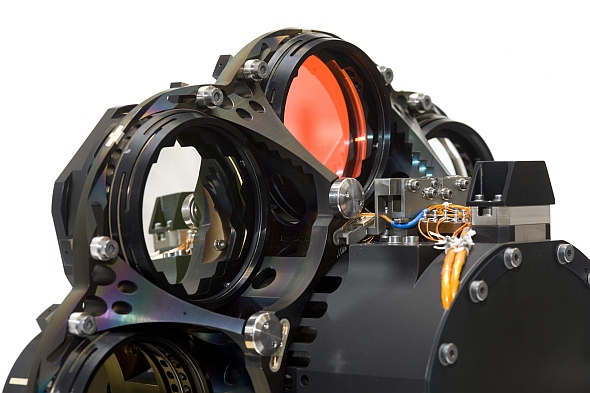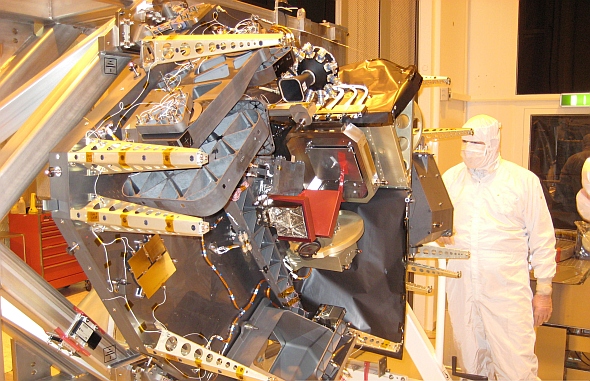 |
|||
| HOME | ISO | HERSCHEL | JWST |
The NIRSpec instrument aboard JWST
The near-infrared spectrograph NIRSpec is the second instrument aboard the James Webb Space Telescope to which the MPIA is contributing. NIRSpec will be provided by the European Space Agency ESA as one of the major European contributions to JWST. The instrument is currently being built by an industrial consortium led by EADS-Astrium, Germany. Our institute is a member of the industrial consortium, and is represented by Hans-Walter Rix in the NIRSpec Science Team.
Among the primary science objectives for NIRSpec are deep extragalactic surveys. Consequently, the instrument design requires a multi-object spectrograph capable of measuring the spectra of up to 100 objects simultaneously in a 3 x 3 arcminute field of view. In addition, NIRSpec includes fixed slits and an integral field unit which provide high contrast spectra of point-like sources and of extended objects, respectively. Six gratings will provide high-resolution (R = 2700) and medium-resolution (R = 1000) spectroscopy over the wavelength range of 1 - 5μm, while a prism will yield lower-resolution (R = 100) spectroscopy over the range 0.6 - 5 μm.
To switch between these different spectroscopic observing modes, NIRSpec is equipped with a grating wheel mechanism carrying the six gratings, the double-pass prism, and also a mirror for target acquisition. The active position in the optical beam is mechanically defined by a ratchet system. An electrical motor moves the next grating into position. The same concept is used for the filter wheel and for the wheel mechanisms of the JWST-MIRI instrument (Fig. 1), yielding synergies between the two projects. The high-precision cryomechanism is jointly being developed by Carl Zeiss Optronics, Austrian Aerospace, and MPIA. The MPIA team is responsible for the procurement of electrical components of the mechanism such as cable harnesses, the DC motor and parts of the position sensor and provides support to both electrical system engineering and cryogenic testing.

|
| Fig.1: The NIRSpec filter wheel mechanism (image credit Carl Zeiss Optronics, Oberkochen). |
The filter wheel mechanism houses a set of edge transmission filters for order separation during the different spectroscopic observations. The filter wheel is also equipped with one clear aperture for imaging and a pupil reference/calibration mirror for alignment and instrument self-calibration purposes. Since NIRSpec will be operated at cryogenic temperatures (T ~ 35 K), both mechanisms have been designed to meet an extremely stringent power dissipation constraint, which must not exceed 69 mW in order to maintain the thermo-mechanical stability of the instrument, an important characteristic of this precision spectrograph.
An engineering test unit (ETU) of the NIRSpec instrument has been built which realistically replicates the thermal, mechanical, electrical and optical characteristics of the actual flight model (Fig. 2). The ETU was subjected to a series of vibration, thermal-vacuum and electromagnetic compatibility tests and will be used by NASA later this year for pre-integration testing with the Integrated Science Instrument Module (ISIM) of JWST.

|
| Fig.2: The NIRSpec engineering test unit (ETU) during the gravity-release test at the Astrium facilities in Ottobrunn (image credit EADS Astrium). |
The integration of the NIRSpec flight model has started recently. The instrument features a highly modular system, consisting of three optics assemblies, and six main opto-mechanical systems including the grating and filter wheel mechanisms, which can be integrated, aligned and tested independently. The optical assembly, which houses all the opto-mechanical assemblies, is located at the heart of the instrument. Silicon carbide, a ceramic material with very high stiffness-to-mass ratio and a very high thermal stability has been selected. This material has an extremely low coefficient of thermal expansion and matches well with the payload supporting structure ISIM, built from carbon fibre. MPIA has been collaborating with EADS-Astrium to verify mechanical properties of the ceramic at low temperatures - required for the successful space qualification of the material.
 click here to get a printer-friendly version of this page click here to get a printer-friendly version of this page |
|
last modified: 26 Mar 2010 for questions or comments please contact the webmaster |
